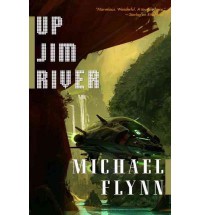 I see that in my review of The January Dancer (TJD) I neglected to mention the frame upon which Michael Flynn hung his story, which is related by “the scarred man” to the harper Méarana of Dangchao Waypoint as they drink uiscebaugh in the Bar on Jehovah. Up Jim River picks up right after the scarred man has finished his tale. I’m not spoiling anything by revealing that he is the Fudir or that Méarana (née Lucia Thompson) is the daughter of Bridget ban (née Francine Thompson), the Hound who accompanied the Fudir, Little Hugh and Greystroke in the previous novel. After the events of TJD, the Fudir – who began life in the Periphery as Donovan, an agent of the Confederation – is taken by Those of Name and interrogated. The questioning shatters his mind into 7+ personalities & for the last twenty years he (they) have been hiding in Jehovah’s Terran ghetto (The Corner). Méarana has come seeking the scarred man to enlist him in her quest to find her mother. Bridget ban has disappeared into the Wild, the uncharted spaces beyond the boundaries of the Periphery, reportedly seeking a Commonwealth artifact that could tip the balance between the United League of the Periphery and the despotic Confederation that rules Earth. Bridget ban’s fellow Hounds have given up the search. Thus, TJD was prolog to the real story that begins when Méarana and the scarred man set out to follow her mother’s trail.
I see that in my review of The January Dancer (TJD) I neglected to mention the frame upon which Michael Flynn hung his story, which is related by “the scarred man” to the harper Méarana of Dangchao Waypoint as they drink uiscebaugh in the Bar on Jehovah. Up Jim River picks up right after the scarred man has finished his tale. I’m not spoiling anything by revealing that he is the Fudir or that Méarana (née Lucia Thompson) is the daughter of Bridget ban (née Francine Thompson), the Hound who accompanied the Fudir, Little Hugh and Greystroke in the previous novel. After the events of TJD, the Fudir – who began life in the Periphery as Donovan, an agent of the Confederation – is taken by Those of Name and interrogated. The questioning shatters his mind into 7+ personalities & for the last twenty years he (they) have been hiding in Jehovah’s Terran ghetto (The Corner). Méarana has come seeking the scarred man to enlist him in her quest to find her mother. Bridget ban has disappeared into the Wild, the uncharted spaces beyond the boundaries of the Periphery, reportedly seeking a Commonwealth artifact that could tip the balance between the United League of the Periphery and the despotic Confederation that rules Earth. Bridget ban’s fellow Hounds have given up the search. Thus, TJD was prolog to the real story that begins when Méarana and the scarred man set out to follow her mother’s trail.Up Jim River is nearly as good as TJD but there are some particulars that prevent it from quite measuring up to its predecessor. First, there is the common disadvantage in a trilogy of being the middle novel – you start out in the middle of a story and you tend to end in the middle. In this case, the problem is minimal. Flynn tells a self-contained, fairly traditional quest story, and the only real disappointment is that we have yet to directly confront Those of Name. The second problem is more substantive. Unlike TJD, I didn’t find any of the new companions Méarana and the scarred man pick up very interesting. The band that set out to find the January Dancer was more vivid and their backgrounds more involving, and so their fates more interesting (outside of the Fudir’s and Méarana’s in this novel). The third problem I had with achieving unalloyed pleasure with Up Jim River was the pacing. For the first 6/7’s of the novel, the pace is rather desultory but in the last 50 pages, it revs up to Warp 10, and we careen up a river and into orbit, where the protagonists finally discover what happened to Bridget ban.
The ending didn’t disappoint but I wish I could have savored it more.
In truth, I enjoyed Flynn’s leisurely jaunt through the Periphery and the Wild because he was having so much fun exploring his universe and dealing with the theme of fact becoming legend becoming myth. For in this book we get a greater understanding of just how deep his future history is. In TJD, it was unclear (at least to me) how distant the fall of the Commonwealth was – a few centuries?, a millennium? It was actually nearly 10,000 years before the story begins, and Flynn takes great delight in showcasing the variety of ways humanity’s colonies have developed. There’s Rickety Thistlewaite, a stop along the Silk Road. There Brythoni and Zhõgwo have mixed to create a planet where the Emperor of Morning Dew sheen – Resilient Services (né Johnny Barcelona) – takes High Tea and personally serves scones and jam to his guests, and the cities carry names like “Tsienchester.” Or there’s the condition of the Terrans who were forcibly transported by the Confederation when it “cleansed” Old Earth. In the subsequent millennia, they’ve achieved a status similar to the ghettoized Jews of Eastern Europe before WW2 –confined to special districts and generally despised by the populations among whom they live.
If you’ve read TJD, then there’s really no choice but to continue with Up Jim River. If you haven’t yet read TJD, I strongly recommend that you do so you can continue on to this volume and then to its denouement – In the Lion's Mouth


